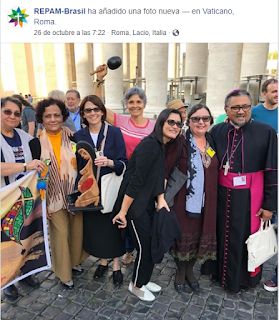October 28, 2019 (LifeSiteNews) — I wonder if, in the long history of the Catholic Church, any pope has ever before blessed an idol, as Pope Francis did in the Vatican gardens a few days ago. That was after the assembled “congregants” had bowed and prayed before that same idol, mind you.
I rather suspect not.
In fact, I am pretty sure that Catholics — popes, bishops, and laity alike — have done precisely the opposite down through the ages. Wherever they have found idols, they have spoken out against them, not only urging their destruction, but often destroying them with their own hands.
Take St. Gregory the Great, for example, who reigned as Pope from 590 to 604 A.D. He is famous for sending the missionary St. Augustine of Canterbury to evangelize the then-pagan Anglo-Saxons in England. In a letter to Abbot Melitus recorded by St. Bede in his Ecclesiastical History of the English People, St. Gregory issued the following instructions:
Tell [Bishop Augustine] that I have decided after long deliberation about the English people, namely that the idol temples of that race should not be destroyed, but only the idols in them. Let blessed water be prepared, and sprinkled in these temples, and altars constructed, and relics deposited. For if these temples are well built, it is essential that they should be transferred from the worship of devils to the service of the true God.
St. Augustine of Canterbury did as he was told, destroying the pagan idols the temples contained while converting the temples themselves into Christian churches. Destroying an idol reveals to everyone — in a way that nothing else does — the utter powerlessness of demons in the presence of Christ.
Many of the churches in Rome occupy the sites, or even the actual structures, of pagan temples, Including the church from which the Pachamama idols were removed and tossed into the Tiber. That church, Santa Maria in Traspontina, was built on the ruins of the Meta Romuli, an ancient Roman pyramid believed to be Romulus’s tomb, where the citizens of pre-Christian Rome went to worship the deified founder of their city.
Bringing a pagan idol into the sacred precincts of a Catholic church would be, without question, a sacrilege. But is that statue of a pregnant, kneeling women really a pagan idol?
Opinions vary.
As an anthropologist, I recognized the statue of a naked and very pregnant woman that was brought into the Vatican. Similar idols were worshiped in the fertility cults of many primitive cultures around the world and still are in the recesses of the Amazon. Not a few such cults demanded human sacrifice as the price of their favors. In the Incan version of the South American Pachamama cult, child sacrifice was practiced.
Some in the Vatican at first claimed that the statues represented Our Lady of the Amazon. This interpretation the Vatican press office was at pains to refute. It repeatedly — and correctly — denied any connection between the Queen of Heaven and the pagan goddess of Mother Earth that the statue represents.
Andrea Tornielli, the editorial director for the Vatican Dicastery for Communication, then tried to explain how it was that the pope came to bless a pagan idol but wound up making things worse. He called the statue "an image of motherhood and the sacredness of life, a traditional symbol for indigenous peoples representing the bond with our ‘mother earth,’ as described by Saint Francis of Assisi in his Canticle of the Creatures.”
Leaving aside the gratuitous reference to Saint Francis, whose name is invoked at every turn, Tornielli is saying that the statues representing “fertility, life and Mother Earth” are exactly what they seem to be: Pachamama idols still worshiped by the primitive peoples of the Amazon as part of a fertility cult.
Now that even Pope Francis himself — who is from South America and has visited the Amazon — has identified the statue as a “Pachamama,” there can be no doubt about “her” identity. Even in the modern versions of the cult found in Peru, Pachamama is conceived of as what one anthropologist called “a non-human sacred/social person with whom a relationship of reciprocity must be maintained.”
In other words, Pachamama is not just a symbolic representation of Mother Earth, but a pagan deity that one must be careful to propitiate, not anger.
Now, as it happens, we Catholics have been hectored for months by the organizers of the Amazonian Synod to take the native beliefs and practices of the indigenous peoples of the Amazon seriously. During the Synod itself, we were constantly reminded of Pope Francis' call to learn from the "ancient wisdom of the indigenous peoples of the Amazon."
The pope’s close friend, Father Antonio Spadaro, put it this way: “An authentically Catholic response must be given to the request of the Amazon communities to adapt the liturgy by valuing the[ir] original cosmo-vision, traditions, symbols, and rites that include transcendent, community and ecological dimensions.”
Well, it turns out that one of the chief ways that “the Amazon communities” express their “cosmo-vision” is by worshiping a pagan deity called Pachamama, to whom they sacrifice animals and, perhaps still, in the remote reaches of the rainforest, the occasional child.
Those who orchestrated the Amazonian Synod can’t have it both ways. Either they take the traditions, symbols, and rites of the Amazonians seriously or not. If they do, then they must recognize that “Pachamama” is a pagan deity and that representations of her are, by definition, idols.
If they don’t, then what is all this business about respecting the “wisdom” of the indigenous tribes really about?
I think by now it should be obvious to most observers that the synod organizers intended to use the Pachamama idol as a mere prop in their morality play — a play they were staging to promote fundamental changes in the priesthood as well as a radical environmental agenda. Her naked figure was supposed to be taken as nothing more than a symbol of respect for the environment. How else to explain their utter confusion when they found themselves embracing what the indigenous tribes of the Amazon still regard as a pagan deity?
In the end, of course, it was clear that those same Amazonian tribes are also, like Pachamama, little more than props in that same morality play. In fact, I believe that it is no exaggeration to say the synod organizers have betrayed the very peoples they claimed to be helping. All the face paint and parrot feathers in the world cannot disguise the fact that they themselves were engaged in a kind of ideological exploitation of the peoples who live there to promote their own agenda.
In the name of protecting the rainforest, the organizers of the synod would condemn the peoples who live there to perpetual poverty. Worse yet, in the name of honoring the “cosmo-vision, traditions, symbols, and rites” of the Amazonian tribes as another path to the “transcendent,” they would leave them in spiritual darkness, bereft of the light of Christ.
How appropriate that Pachamama is shown naked and pregnant, downcast and kneeling.
For if this piece of wood carved into a female shape is a symbol of anything, it is a symbol of the poverty and misery — both spiritual and material — that await not only the Amazon indigenous, but the Universal Church as a whole, if the Synod organizers were to have their way.
Let us pray that they don’t.
Steven W. Mosher is the president of the Population Research Institute and the author of Bully of Asia: Why China’s Dream Is the New Threat to World Order


























































